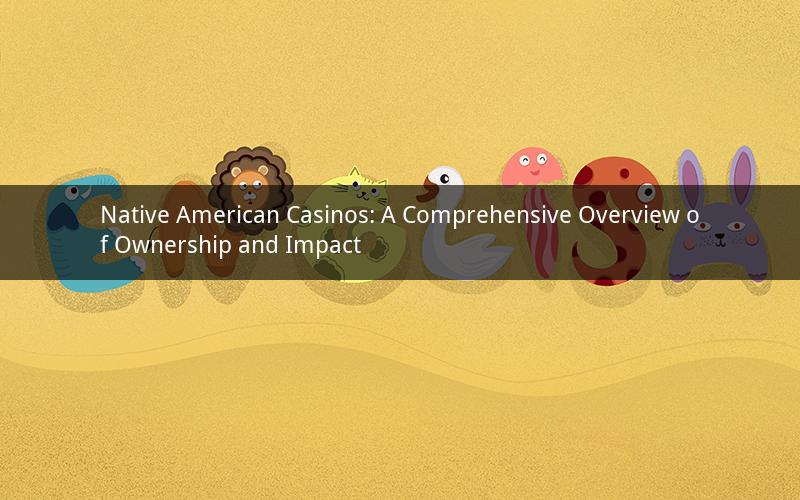
Native American casinos have become an integral part of the gaming industry, contributing significantly to the economy and cultural preservation of tribes across the United States. This article explores the number of casinos owned by Native Americans, their impact on tribal communities, and the legal framework surrounding their operations.
The Rise of Native American Casinos
The history of Native American casinos dates back to the late 20th century when the Indian Gaming Regulatory Act (IGRA) was enacted in 1988. This landmark legislation allowed tribes to establish and operate casinos on their sovereign lands, provided they entered into a compact with the state in which the casino was located. The IGRA has been instrumental in the growth of Native American casinos, leading to an increase in their number and influence.
The Number of Native American Casinos
The number of casinos owned by Native Americans varies depending on the source. As of 2021, there are approximately 500 casinos owned by Native American tribes across the United States. This figure includes both land-based and online casinos, as well as tribal gaming enterprises that offer a variety of gaming options, such as slot machines, poker, blackjack, and bingo.
Impact on Tribal Communities
Native American casinos have had a profound impact on tribal communities, offering numerous benefits. These include:
1. Economic Growth: Casinos generate substantial revenue for tribes, which can be used to fund education, healthcare, and infrastructure projects. This financial boost has allowed tribes to invest in their communities, creating jobs and improving the overall quality of life.
2. Cultural Preservation: Many Native American tribes use casino revenue to support cultural programs, such as language revitalization, traditional art, and dance. This helps preserve the rich heritage of tribes and fosters cultural pride among their members.
3. Tribal Sovereignty: Casinos are a symbol of tribal sovereignty, as they are operated and controlled by tribes themselves. This empowers tribes to make decisions regarding their gaming enterprises, fostering a sense of self-determination.
4. Social Services: Native American casinos often provide funding for social services, such as counseling, job training, and addiction treatment programs. These services help address the challenges faced by tribal members and contribute to a healthier community.
Legal Framework
The legal framework surrounding Native American casinos is complex and has evolved over time. The IGRA established a three-tiered regulatory system, with tribes, states, and the federal government playing crucial roles. Here are some key aspects of the legal framework:
1. Class III Gaming: IGRA defines Class III gaming as games that are not considered traditional to tribes, such as slot machines and blackjack. Tribes must enter into a compact with the state to offer Class III gaming.
2. Class II Gaming: This category includes traditional games, such as bingo and card games, which tribes can operate without a compact. However, they must comply with federal regulations.
3. Compacts: Compacts are agreements between tribes and states that outline the terms and conditions for operating casinos. These agreements typically address issues such as the types of games offered, revenue sharing, and regulatory oversight.
4. The U.S. Department of the Interior: The Interior Department is responsible for overseeing tribal gaming and ensuring that tribes comply with the IGRA and other federal regulations.
Challenges and Controversies
Despite the success of Native American casinos, there are challenges and controversies associated with their operations. Some of these include:
1. Compacting Disputes: Tribes and states often face disagreements over compacts, leading to legal battles and delays in casino development.
2. Gaming Addictions: Native American casinos have been criticized for contributing to gambling addictions among tribal members and neighboring communities.
3. Environmental Impact: Casino development can lead to environmental concerns, such as the destruction of natural habitats and water pollution.
4. Social Costs: Some argue that the social costs of Native American casinos, such as increased crime rates and strained community relationships, outweigh the economic benefits.
Conclusion
Native American casinos have become an essential part of the gaming industry, providing significant economic, cultural, and social benefits to tribes across the United States. While challenges and controversies persist, the number of casinos owned by Native Americans continues to grow, reflecting the ongoing influence of tribes in the gaming landscape.
Questions and Answers
1. Q: How many Native American casinos are there in the United States?
A: As of 2021, there are approximately 500 casinos owned by Native American tribes across the United States.
2. Q: What is the legal framework for Native American casinos?
A: The Indian Gaming Regulatory Act (IGRA) of 1988 established the legal framework for Native American casinos, outlining regulations and the process for tribes to enter into compacts with states.
3. Q: How do Native American casinos benefit tribal communities?
A: Casinos generate substantial revenue for tribes, which can be used to fund education, healthcare, infrastructure, and cultural preservation programs.
4. Q: What challenges do Native American casinos face?
A: Challenges include compacting disputes with states, the potential for gaming addictions, environmental concerns, and social costs such as increased crime rates.
5. Q: How does the U.S. Department of the Interior oversee tribal gaming?
A: The Department of the Interior is responsible for overseeing tribal gaming, ensuring that tribes comply with the Indian Gaming Regulatory Act and other federal regulations.